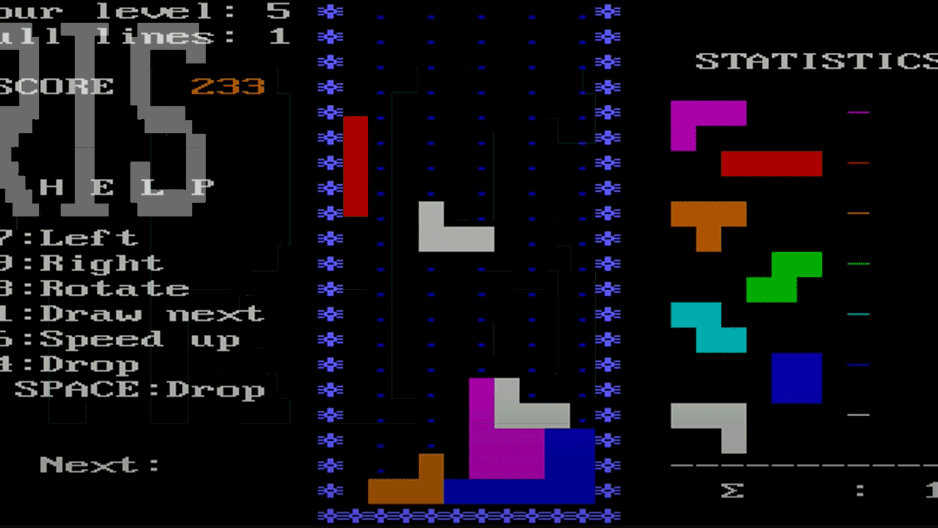Falling into place: piecing together Tetris' enduring legacy
Temple experts Thomas Sharpe, video game expert and adjunct assistant professor of film and media arts; and David Futer, professor of mathematics, weigh in on what makes Tetris the perfect video game.

Today, there is no shortage of options to choose from when it comes to entertainment, especially in the wild world of video gaming. Yet somehow, one arcade classic has withstood the test of time and continues to be enjoyed by millions today. Despite its simplicity and its pre-Internet inception, millions of players still know and love one simple game of stacking shapes: Tetris.
Most people have probably played Tetris at least once in their lives. The game’s popularity is so far-reaching, in fact, that it is joining the ranks of Mario, Sonic the Hedgehog and Detective Pikachu in the realm of video game movie adaptations.
The Tetris movie is due to be released for streaming on Apple TV+ on March 31. The film stars actor Taron Egerton as Dutch video game designer Henk Rogers, who is on a complicated quest to bring the Soviet game that he describes as “poetry” to global audiences. “It’s art and math all working in magical synchronicity. It’s the perfect game,” Egerton’s character says.
That might sound like an extravagant description of a simple game of colorful falling blocks. But video game design expert and Adjunct Assistant Professor of Film and Media Arts Thomas Sharpe and Professor of Mathematics David Futer explain the surprisingly complex combination of art and math that have allowed such a simple game to entertain children and adults for generations.
Key takeaways
-
Released in 1984, Tetris was the first popular puzzle video game and has sold more than 70 million physical copies and over 425 million digital downloads to date.
-
To this day a variety of Tetris editions remain popular; the game is available on more platforms than any other video game in history and its reach continues to grow through Twitch streamers, content creators and professional tournaments.
-
Thomas Sharpe, video game expert and adjunct assistant professor of film and media arts in the School of Theater, Film and Media Arts: Tetris is the gold standard of arcade gameplay design. Its simple gameplay mechanics result in a low barrier to entry but a high “skill ceiling,” and professors and students continue to study the game’s design nearly 40 years after its release.
-
David Futer, professor of mathematics in the College of Science and Technology: Mathematicians and gamers alike are fascinated by simple puzzle games that lead to an infinite number of complex outcomes. Tetris has mastered this formula.
How 'Tetris' was made
Tetris begins with an empty screen, and requires the player to fit falling blocks together like a puzzle. There are seven shapes composed of four blocks each, and they fall into the space one at a time at a fixed speed. The player’s goal is to rotate the shapes as they fall to complete solid rows without gaps. When a row is fully complete, it disappears, creating more space to keep playing. The game is over when the blocks reach the top of the screen.
This simple game of shapes was invented in the Soviet Union in 1984 by Alexey Pajitnov. He was inspired by the puzzle game Pentaminoes, which uses five-block pieces to achieve a similar goal as Tetris: fill up the board with no gaps. Pajitnov’s spin on the game was to use only four-block pieces, also known as tetrominoes. He called it Tetris, a combination of “tetra” for the Greek word for “four” and his favorite sport, tennis.
The first computer that Tetris was suited for was the IBM PC. From this first version was born a web of copyright battles, but by the late ’80s it had been adapted, or ported, for several other popular systems, such as the Atari ST. Fast forward to 2010, and Tetris had set the Guinness World Record for the most ported video game in history, and several additional online and mobile versions have been released since then. Today, Tetris.com continues to host several different versions, including the battle royale-style Tetris 99 and the multiplayer Tetris Friends.
Breaking down the magical math behind 'Tetris'
 Futer explained that the game is intriguing from a mathematical perspective because there is a limited space on the screen and only seven shapes to use. “The elegance of the game comes out of the simple geometry involved,” Futer said. “Mathematicians like games where very simple rules lead to complex phenomena.”
Futer explained that the game is intriguing from a mathematical perspective because there is a limited space on the screen and only seven shapes to use. “The elegance of the game comes out of the simple geometry involved,” Futer said. “Mathematicians like games where very simple rules lead to complex phenomena.”
He explained that not only do Tetris’ rules and endless possibilities create an interesting puzzle, but such puzzles have captured the minds of mathematicians for thousands of years. One of these games is Go, an ancient strategy board game in which two players compete to surround more territory than the other. Similar to Tetris, Go has simple pieces and rules, but can create seemingly endless combinations of moves and situations. Another is Blokus, a more modern board game using similar pieces to Tetris to fill up a board. Clearly, mathematicians have been fascinated by simple puzzle games for thousands of years, so it is no surprise that the video game generation came up with a digital answer to Blokus and Go.
What makes 'Tetris' so addictive?
Tetris’ continuously falling blocks provide endless possibilities for a unique game, every time. These endless potential outcomes are a large part of what makes the game so intriguing to beginners and mathematicians alike, and what has made it one of the most beloved games in history.
Tetris is intuitive to play, and its rules can be picked up by children and adults alike within minutes. These simple rules and easy gameplay have allowed Tetris to stand the test of time, and it doesn’t seem like the game is going anywhere. As of 2014, Tetris had sold more than 70 million physical copies and over 425 million digital downloads, making it one of the bestselling video game franchises of all time. This data shows that not only is Tetris as popular as ever, it’s still growing.
Why is 'Tetris' the gold standard for gameplay design?
Due to its immense popularity and impressive longevity, Tetris is of particular interest to game designers.
 “Game developers continue to study Tetris as a gold standard of [video] gameplay design,” said Sharpe. “It is constantly dissected, reconstructed and remixed by students and professionals alike to understand the essence of gameplay mechanics.” Gameplay mechanics is a concept with no agreed-upon definition, but one that largely describes any set of rules by which a game is played.
“Game developers continue to study Tetris as a gold standard of [video] gameplay design,” said Sharpe. “It is constantly dissected, reconstructed and remixed by students and professionals alike to understand the essence of gameplay mechanics.” Gameplay mechanics is a concept with no agreed-upon definition, but one that largely describes any set of rules by which a game is played.
For Tetris, these mechanics include the shape of the blocks, the speed at which they fall, the size of the space they fill and the speed at which they can be moved. These mechanics have become a great device for teaching video game design because they are some of the simplest, but most successful, in the entire arcade medium. This allows students to learn how to make games fun and interesting without overcomplicating them.
The simple mechanics of the game also translate to a lack of a barrier to entry. Its rules can be understood almost instantly, which means anyone can play Tetris. At the same time, Sharpe says, there is also a high “skill ceiling,” or limitation on how far one can progress in the game. In theory, Tetris could last forever. This combination of easy-to-understand rules and seemingly limitless levels of complexity are some of the hallmarks of great game design, and what makes Tetris worth studying.
Being simple to learn yet difficult to master is much of what has allowed Tetris to not just endure the past four decades, but continually grow its player base and mainstream appeal. For example, there are professional Tetris players and streamers such as Wumbo and Caboozled, some of whom have amassed followings on YouTube and Twitch, and even a Classic Tetris World Championship. At the same time, young people are still gravitating to Tetris and some of its many iterations. Even as new features are added to the game such as multiplayer modes, improved graphics and additional rules, the game always centers its essential mechanics on falling blocks and disappearing rows.
Stacking it all up
If the last four decades have been any indication, Tetris’ popularity and playability will continue to serve as cornerstones of the video game industry. Its tenure has largely been the result of its simple, elegant game design, one that students, teachers and mathematicians are all still studying to this day. Tetris has also captivated serious and casual gamers alike, with its intuitive rules and potential for endlessly complex configurations. It is no wonder, then, that Tetris has stood the test of time, outlasting other arcade classics, and is making its move to the big screen.
Learn more
- Science at Temple: The College of Science and Technology is home to top-notch faculty, exciting research opportunities and coursework that prepares students for a career in the science fields.
- Temple in the Spotlight: The School of Theater, Film and Media Arts is part of the Center for the Performing and Cinematic Arts at Temple University, and leads students to break barriers in artistic media.
- Become an Owl: Learn more about applying for one of our undergraduate, graduate or professional programs.


